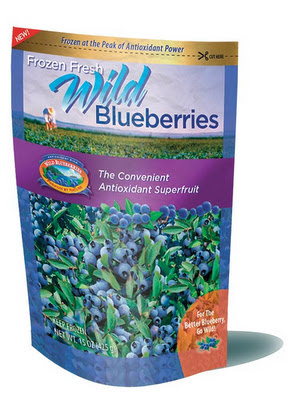As we say goodbye to summer, one of the big takeaways was that it was unusually hot and steamy. Much of the country experienced heat waves, and staying hydrated, nourished and energized was critically important. Smoothies are a great way to start your day by getting your nutrition in one easy grab-n-go package.

Over nine weeks this summer, we shared more than 25 new Wild Blueberry smoothie recipes developed by some of our favorite nutrition and healthy lifestyle bloggers. We also selected a number of additional recipes to share from our existing 120 smoothie recipes – a rich resource for any smoothie lover. So, which were your favorites? Below are the top five most shared, liked, and talked about smoothie recipes from our Wild Your Smoothie Summer:
Created by Danielle Omar, a leading registered dietitian, clean-eating coach, teacher, cookbook author, and blogger behind Food Confidence, this breakfast smoothie combines Matcha green tea powder, a trending ingredient known for its antioxidant, detoxing and weight loss benefits, with frozen fresh Wild Blueberries also known for being an antioxidant-rich superfruit. Wild Blueberries get their powerful antioxidant protection from anthocyanins, the flavonoids found in their gorgeous blue pigment. These flavonoids have the ability to neutralize free radicals and help prevent cell damage. Antioxidants also protect against inflammation, thought to be a leading factor in brain aging, Alzheimer’s disease, and other degenerative diseases.
This colorful, layered, allergy-friendly, kid-friendly smoothie was created by Kelly Roenicke, one of our “Wild Your Smoothie” Recipe contest winners and author of The Pretty Bee: Allergy Friendly Eats blog. Kelly calls it “a treat for the eyes and the taste buds.” This smoothie features a pink bottom layer using blended frozen bananas and raspberries. Next comes the antioxidant-and fiber-rich Wild Blueberry layer. She tops it all off with hemp hearts to add more healthy fats and proteins. Not only is this smoothie delicious and fun, but it’s also naturally free of the top 8 allergens because of the ingredients she selected – frozen fruit, coconut milk and hemp seeds.
When Gina Matsoukas of Running to the Kitchen proposed a Wild Blueberry smoothie that included lavender as an ingredient, we were intrigued. She told us that lavender, also rich in antioxidants, could help promote gut health and reduce bloating. Combined with the frozen Wild Blueberries, this smoothie is an antioxidant powerhouse and a great way to start your day.
Another beautiful layered smoothie, this one is packed with both Wild Blueberries and green veggies (spinach). According to its creator, registered dietitian Kara Lydon and the voice behind The Foodie Dietitian, this savory Wild Blueberry Green Smoothie is good for you because there’s no sugar added and it’s a good source of fiber, protein and healthy fat – the ultimate nutrient trifecta for lasting energy and satiety. So if you have a fear of green smoothies because you think they’ll taste bad, this is a good one to try because using Wild Blueberries will mask the bitterness without having to add sweeteners.
Beets were another “hot” ingredient this summer. We think it’s because – like Wild Blueberries — beets are a beautiful deep purple food with excellent antioxidant and anti-inflammatory properties. To showcase this fun ingredient Danielle Omar of Food Confidence combined it with frozen Wild Blueberries to create a refreshing and stunning smoothie. Danielle says it’s perfect for breakfast because of the cleansing qualities of beetroot combined with the fiber-richness and sweet-and-tart taste of Wild Blueberries.
So if you love healthy smoothies, keep a supply of frozen Wild Blueberries in your freezer all year long. And if you’re looking to change up your smoothie routine and “wild” your smoothie try to one of these amazing smoothie recipes. For more recipes visit our Wild Your Smoothie Recipes.

























